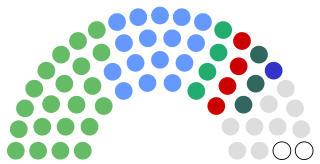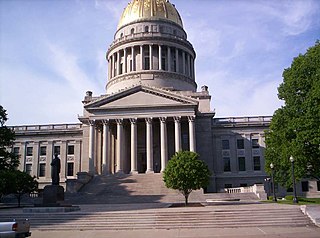
Ireland is a parliamentary, representative democratic republic and a member state of the European Union. While the head of state is the popularly elected President of Ireland, it is a largely ceremonial position, with real political power being vested in the Taoiseach, who is nominated by the Dáil and is the head of the government.
The Republic of China, commonly known as Taiwan is governed in a framework of a representative democratic republic under a Five-Power system envisioned by Sun Yat-sen, whereby under the constitutional amendments, the President is head of state and the Premier is head of government, and of a multi-party system. Executive power is exercised by the government. Legislative power is vested in primarily with the parliament and limited by government. The Judiciary is independent of the executive and the legislature. In addition, the Civil service power is in charge of validating the qualification of civil servants and the supervision auditory power inspects, reviews, and audits the policies and operations of the government. The party system is dominated by the Kuomintang, which favors closer links to mainland China, and the Democratic Progressive Party, which favors Taiwanese nationalism.

The president of the Republic of China, now often referred to as the president of Taiwan, is the head of state of the Republic of China (ROC), as well as the commander-in-chief of the Republic of China Armed Forces. The position once had authority of ruling over Mainland China, but its remaining jurisdictions has been limited to Taiwan, Penghu, Kinmen, Matsu and other smaller islands since the conclusion of Second Chinese Civil War.

The Legislative Yuan is the unicameral legislature of the Republic of China (Taiwan) located in Taipei. The Legislative Yuan is composed of 113 members, who are directly elected for 4-year terms by people of the Taiwan Area through a parallel voting system.

The Oireachtas, sometimes referred to as Oireachtas Éireann, is the bicameral parliament of Ireland. The Oireachtas consists of:

The Irish Republic was an unrecognised revolutionary state that declared its independence from the United Kingdom in January 1919. The Republic claimed jurisdiction over the whole island of Ireland, but by 1920 its functional control was limited to only 21 of Ireland's 32 counties, and British state forces maintained a presence across much of the north-east, as well as Cork, Dublin and other major towns. The republic was strongest in rural areas, and through its military forces was able to influence the population in urban areas that it did not directly control.
The Second Dáil was Dáil Éireann as it convened from 16 August 1921 until 8 June 1922. From 1919 to 1922, Dáil Éireann was the revolutionary parliament of the self-proclaimed Irish Republic. The Second Dáil consisted of members elected at the 1921 elections, but with only members of Sinn Féin taking their seats. On 7 January 1922, it ratified the Anglo-Irish Treaty by 64 votes to 57 which ended the War of Independence and led to the establishment of the Irish Free State on 6 December 1922.
The First Dáil was Dáil Éireann as it convened from 1919 to 1921. It was the first meeting of the unicameral parliament of the revolutionary Irish Republic. In the December 1918 election to the Parliament of the United Kingdom, the Irish republican party Sinn Féin won a landslide victory in Ireland. In line with their manifesto, its MPs refused to take their seats, and on 21 January 1919 they founded a separate parliament in Dublin called Dáil Éireann. They declared Irish independence, ratifying the Proclamation of the Irish Republic that had been issued in the 1916 Easter Rising, and adopted a provisional constitution.
Bicameralism is a type of legislature that is divided into two separate assemblies, chambers, or houses, known as a bicameral legislature. Bicameralism is distinguished from unicameralism, in which all members deliberate and vote as a single group. As of 2022, roughly 40% of world's national legislatures are bicameral, while unicameralism represents 60% nationally, and much more at the subnational level.

The National Assembly was the authoritative legislative body of the Republic of China, commonly referred to as Taiwan after 1949, from 1947 to 2005. Along with the Control Yuan and the Legislative Yuan, the National Assembly formed the tricameral parliament of China. If still functional, at 3,045 members, the National Assembly would have been the largest parliamentary chamber in the world.
The history of the Republic of China begins after the Qing dynasty in 1912, when the Xinhai Revolution and the formation of the Republic of China put an end to 2,000 years of imperial rule. The Republic experienced many trials and tribulations after its founding which included being dominated by elements as disparate as warlord generals and foreign powers.
Tricameralism is the practice of having three legislative or parliamentary chambers. It is contrasted with unicameralism and bicameralism, each of which is far more common.
An indirect election or hierarchical voting is an election in which voters do not choose directly among candidates or parties for an office, but elect people who in turn choose candidates or parties. It is one of the oldest forms of elections and is used by many countries for heads of state, cabinets, heads of government, and/or upper houses. It is also used for some supranational legislatures.

Dáil Éireann, also called the Revolutionary Dáil, was the revolutionary, unicameral parliament of the Irish Republic from 1919 to 1922. The Dáil was first formed on 21 January 1919 in Dublin by 69 Sinn Féin MPs elected in the 1918 United Kingdom general election, who had won 73 seats of the 105 seats in Ireland, with four party candidates elected for two constituencies. Their manifesto refused to recognise the British parliament at Westminster and instead established an independent legislature in Dublin. The convention of the First Dáil coincided with the beginning of the War of Independence.

The Oireachtas of the Irish Free State was the legislature of the Irish Free State from 1922 until 1937. It was established by the 1922 Constitution of Ireland which was based from the Anglo-Irish Treaty. It was the first independent Irish Parliament officially recognised outside Ireland since the historic Parliament of Ireland which was abolished with the Acts of Union 1800.
Irish republican legitimism denies the legitimacy of the political entities of the Republic of Ireland and Northern Ireland and posits that the pre-partition Irish Republic continues to exist. It is a more extreme form of Irish republicanism, which denotes rejection of all British rule in Ireland. The concept shapes aspects of, but is not synonymous with, abstentionism.

A parliamentary republic is a republic that operates under a parliamentary system of government where the executive branch derives its legitimacy from and is accountable to the legislature. There are a number of variations of parliamentary republics. Most have a clear differentiation between the head of government and the head of state, with the head of government holding real power, much as in constitutional monarchies. However, in some countries the head of state has 'reserve powers' to use at their discretion as a non-partisan 'referee' of the political process. Some have combined the roles of head of state and head of government, much like presidential systems, but with a dependency upon parliamentary power.

The Government of the Republic of China is the national government of the Republic of China (ROC) whose de facto territory currently consists of Taiwan, Penghu, Kinmen, Matsu, and other island groups in the "free area". Governed by the Democratic Progressive Party (DPP) since 2016, the president is the head of state. The government consists of the presidency and five branches (Yuan): the Executive Yuan, Legislative Yuan, Judicial Yuan, Examination Yuan, and Control Yuan.

The Government of West Virginia is modeled after the Government of the United States, with three branches: the executive, consisting of the Governor of West Virginia and the other elected constitutional officers; the legislative, consisting of the West Virginia Legislature which includes the Senate and the House of Delegates; and the judicial, consisting of the West Virginia Supreme Court of Appeals and lower courts.










